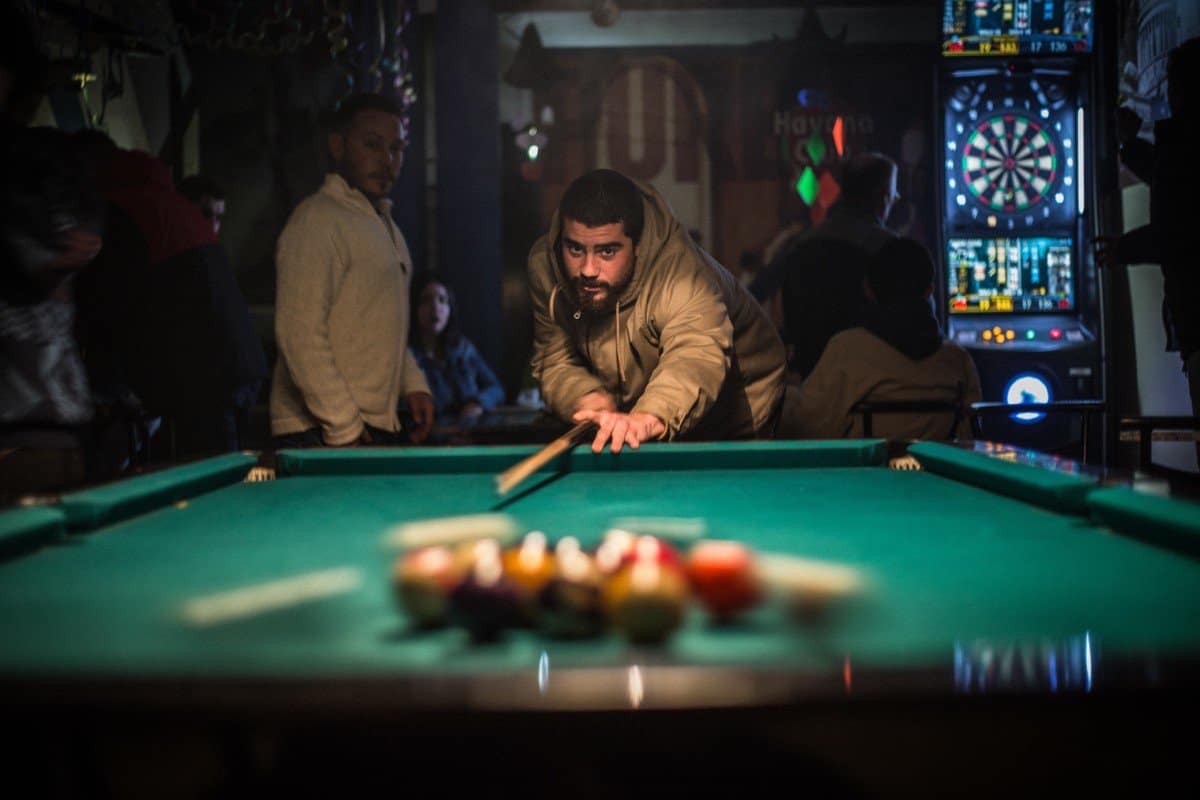Measuring a pool table is simple and easy. It comes in handy when the pool mover is asking what size table you have or if you’re thinking about buying your own table.
How do you accurately measure a pool table? You use a tape measure and measure the shortest side first (which is the Width). You must measure from inside the rails, short rail to short rail. Your starting point is where the ball touches the rail, not below it or from the edge of the table.
With your table Width, you can use this table to tell which Length you have and ultimately what table size you have.
| Table Size | Playing Surface Dimensions | Table Dimensions |
| 7 Foot | 39.5” x 79” | 3.5’ x 7’ |
| 8 Foot (Standard Home) | 44” x 88” | 4’ x 8’ |
| 8 Foot (Pro Size) | 46” x 92” | 4.25’ x 8.5’ |
| 9 Foot | 50” x 100” | 4.5’ x 9’ |
As an example, if you measure 44” or 44 inches, it means your length is 88” and you have a standard 8 Foot Size Pool Table.
Here is a helpful YouTube video!
Looking for a solid pool table to check out? A lot of folks enjoy the Barrington Springdale Pool Table. Check it out on Amazon and see why it’s one of the best sellers.
The 4 Common Sizes of Pool Tables
There are 4 common Pool Table sizes. Ranging from the bar box 7 foot table to the giant 9 foot table where many struggle to adapt to the size.
- 7 foot – Bar Size – 39 inches Wide (+/-1in)
- 8 foot – Standard Home – 44 inches Wide (+/-1in)
- Professional 8 foot (AKA Pro 8) – 46 inches Wide (+/-1/8in)
- 9 foot – Professional Tournament Size- 50 inches Wide (+/-1/8in)
As you can see, pool tables can come in many different sizes. The different sizes fit the different needs of the average joe, professionals, and businesses.
7 foot Pool tables Pool halls, bars and restaurants will often use these tables because they take up less space, meaning more tables, and more players getting to play!
8 foot – Standard Home -This is usually what you’ll find in a home, and most often a billiards store will have one of each type for you to check out. If you just want a good table to play on with a little more room than the 7 foot table, this is a good option.
Professional 8 foot (AKA Pro 8) Not all professional tables are 9 foot. More often than not, local pool tournaments you may enter would be run on the Pro 8 tables. This one is a solid choice for your home if you want the best of both casual and professional play- think of it as Goldilocks’ third bowl of porridge.
9 foot – Professional Size- The Grand Poobah Big Daddy of pool tables, these are fun to play on and what you have seen on TV if you’ve watched any WPA pool tournaments. Any bigger than this and you’re playing snooker.
Snooker – Just for fun and curiosity sake, a snooker table is a monster measuring 11ft 8-1/2in long by 5ft 10in wide!
Related Content: 11 Mistakes to Avoid when Buying a Used Pool Table
Which Exact Part to Measure?
Pool Tables are Twice as Long as they are Wide. You don’t have to measure the long dimensions if you don’t want to, or if you don’t have some one to help you keep from scuffing the felt with your tape measurer. If a person is in the business of making pool tables and wants to stay in that business, this will be the case. 1×2 ratio.
Pool tables are measured by their width. This we can assume because this is an easier way for most people to reach. Unless they are giants.
The “Width” is from Nose-to-Nose of the long cushions (where your center pocket is). The Nose of the cushion is where the balls make contact with the cushion. The reason for this is that different pool manufacturers will have different sizes or angles of cushion.
There is some room for error! Though usually not more than one inch, if you are a perfectionist you need to know that the different manufacturers, cushions, and install process mean that you will not get exactly 42”x 84” when you hear “7 foot table”.
What’s more important is that the distances between opposite rails are uniform, and that the rails will behave the same way around the table.
Professional versus Casual Tables. If you are a perfectionist, don’t let the previous talk about error fool you. Just as with anything, the higher the stakes the higher the standards, and the less room for error!
WPA Professional Tables are allowed only 1/8th of an inch for error. If you plan to play tournaments, your tables will be either 9 foot (100”x50”) or 8 foot (92”x46”).
What about Height? Official pool table heights, again according to WPA specifications, will be between 29-1/4” and 31”. This will be the actual table height, or the “table bed” where the balls are placed.
If you are STILL super curious about every official measurement of the pool table, that’s alright too! The official WPA pool table dimensions can be found at their official site : https://wpapool.com/equipment-specifications/
How Much Space Do I Need For a Pool Table?
Ever wonder how much space you need for a pool table? We made this helpful table below:
| Table Size | Minimum Room Size |
| 7 Foot | 16’ 8” x 13’ 6” |
| 8 Foot | 17’4” x 13’11” |
| 8 Foot Pro | 17’9” x 14’1” |
| 9 Foot | 18’4” x 14’6” |
Having the right sized room can be difficult to find.
I know that it made the search for renting an apartment a challenge. You read that right, I had a pool table in my apartment! Eventually I upgraded to my own home and even that was a big factor in the buying decision.
Be sure to have the measurements handy. It would be a bummer to find out your pool stick hits the wall because you didn’t check beforehand.
Why does Pool Table Size Matter?
As their names suggest, these are the sizes and where you will most often run into them for various reasons.
Here are a few ways the size of the table will affect your pool game.
Smaller Tables mean:
- Faster Games. If you like playing several games back to back, consider smaller tables. You will be able to make more shots more often, simply because everything is closer together. Perfect if you prefer best 3 out of five or 5 out of 7! It’s just math, silly.
- Shorter Shots. Because of the shorter distances, you will have more opportunity to get straight easy shots. Make sure you don’t miss by practicing some of these simple drills.
- Easier Bank Shots. Less distance between the rails and your target balls mean you have slightly more room for error when banking. Use this to your advantage and get around your opponents balls by mastering bank shots!
- More Clutter. Your opponents balls will be in the way more often. This is a perfect reason to understand how to properly use safety shots until you get a good lay to run the table!
Bigger Tables mean:
- Longer Shots. If you get satisfaction from a good long shot across the table, play on a 9 foot table before deciding which one to purchase. It may be well worth the extra room you add on to your house for it!
- Cue Ball Control. More green means lining up your next shot will be even more important. Be sure to practice cue ball control to give yourself a better opportunity to run the table.
- More Room to Play. A bigger table also means more room for everyone’s balls. This can be great if you enjoy playing variations of pool such as cut-throat, where three people need room to run around.
- Room to Grow. Chances are, if you are able to play well on a larger table, you can play even better on a small table. Having the opportunity to practice on a larger table will improve your cue control, ability to see long shots, and help you realize the importance of setting up your next shot.
Each Pool Table Size Presents Unique Opportunity
If you’re not sure which to buy, play on a couple and see what sort of feel you prefer!
The best way to understand sizing, and your own personal preference, is to try out various sizes and see how they feel to you. If you plan on playing regularly with the same partner or spouse, bring them along with you as you shop around for tables.
Especially if this table is going to be in your home, you will need to be sure that you each agree on the size, and the color!

